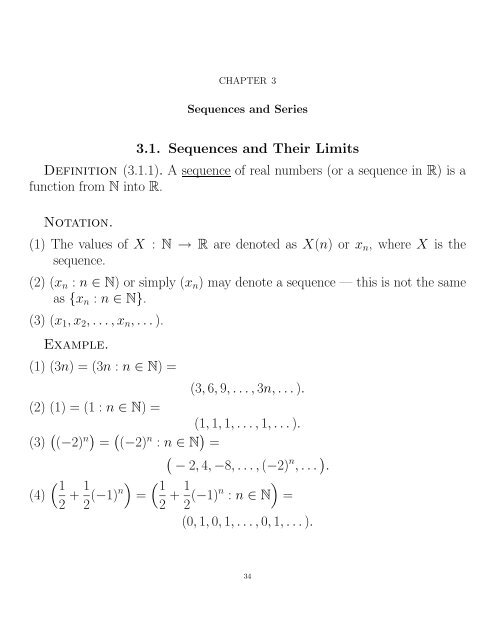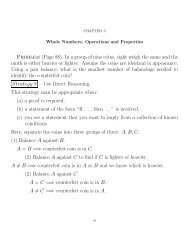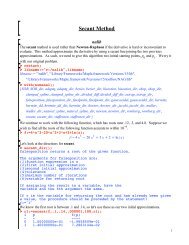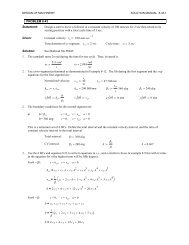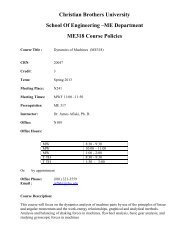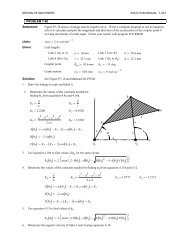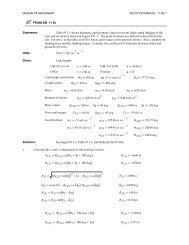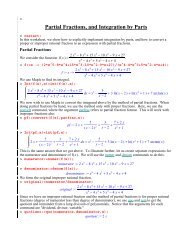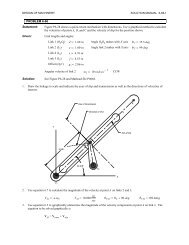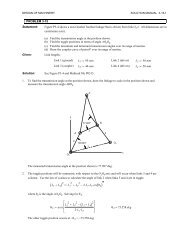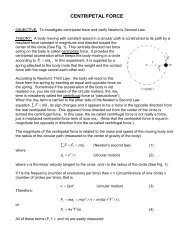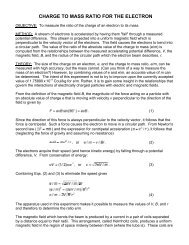Chapter 3 - CBU
Chapter 3 - CBU
Chapter 3 - CBU
Create successful ePaper yourself
Turn your PDF publications into a flip-book with our unique Google optimized e-Paper software.
CHAPTER 3Sequences and Series3.1. Sequences and Their LimitsDefinition (3.1.1). A sequence of real numbers (or a sequence in R) is afunction from N into R.Notation.(1) The values of X : N ! R are denoted as X(n) or x n , where X is thesequence.(2) (x n : n 2 N) or simply (x n ) may denote a sequence — this is not the sameas {x n : n 2 N}.(3) (x 1 , x 2 , . . . , x n , . . . ).Example.(1) (3n) = (3n : n 2 N) =(3, 6, 9, . . . , 3n, . . . ).(2) (1) = (1 : n 2 N) =(1, 1, 1, . . . , 1, . . . ).(3) ( 2) n = ( 2) n : n 2 N =(4)⇣ 12 + 1 2 (2, 4, 8, . . . , ( 2) n , . . . .⌘ ⇣ 1 1)n =2 + 1 ⌘2 ( 1)n : n 2 N =(0, 1, 0, 1, . . . , 0, 1, . . . ).34
(5)✓ ⇣n2⌘12 + 1 2 ( 1)n◆ =✓ ⇣n ⌘12 + 1 2 ( 1)n : n 2 N◆=2⇣1, 1, 1, 2, 1, 3, 1, 4, . . . , 1, n ⌘2 , . . . .3.1. SEQUENCES AND THEIR LIMITS 35Sequences may also be defined inductively or recursively.Example.(1) x 1 = 5, x n+1 = 2x n 3 (n 1) gives(5, 7, 11, 19, 35, . . . ).(2) Fibonacci sequence: x 1 = x 2 = 1, x n+1 = x n 1 + x n (n 2) gives(1, 1, 2, 3, 5, 8, 13, . . . ).Definition (3.1.3). A sequence X = (x n ) in R is said to converge to x 2 R,or have limit x, if8 ✏ > 0 9 K(✏) 2 N 38 n K(✏), |x n x| < ✏.We write this as lim X = x, lim(x n ) = x, limn!1x n = x, orx n ! x as n ! 1.A sequence that converges is called convergent, one that does not divergent.⇣ 1Example. lim = 0.n⌘Proof. Let ✏ > 0 be given. By the Archimedean property,19 K(✏) 2 N 3 < ✏. Then,K(✏)for n K(✏), 1 n apple 1 , and soK(✏)10 = 1 n n apple 1K(✏) < ✏.⇣ 1Thus lim = 0 by definition. ⇤n⌘
36 3. SEQUENCES AND SERIESCalculator Visualisation1limn!1 n = lim 1= 0 if 8 ✏ > 0,x!1 xwith yMin = 0 ✏ and yMax = 0 + ✏,you can find K(✏) 2 N 3xMin = K(✏) and xMax = 1E99,ifthe graph only enters the screen from the left and exits from the right.Theorem (3.1.4 — Uniqueness of Limits). A sequence in R can have atmost one limit.Proof. [The ✏ 2 technique.]Suppose lim(x n ) = x 0 and lim(x n ) = x 00 . By Theorem 2.1.9,it su ces to show that |x 0x 00 | < ✏ 8 ✏ > 0, for then|x 0 x 00 | = 0 =) x 0 = x 00 . Let ✏ > 0 be given.Since lim(x n ) = x 0 , 9 K 0 2 N 3 8 n K 0 , |x n x 0 | < ✏ 2 .Since lim(x n ) = x 00 , 9 K 00 2 N 3 8 n K 00 , |x n x 00 | < ✏ 2 .Let K = max{K 0 , K 00 }. Then n K =) n K 0 and n K 00 =)|x 0 x 00 | = |x| 0 x n + x{z n x 00 |}smugglingapple|x 0 x n | + |x n x 00 | < ✏ 2 + ✏ 2 = ✏. ⇤
3.1. SEQUENCES AND THEIR LIMITS 37Theorem (3.1.5). Let X = (x n ) be a sequence in R, and let x 2 R. Thefollowing are equivalent:(a) X converges to x.(b) 8 ✏ > 0, 9 K 2 N 3 8 n K, |x n x| < ✏.(c) 8 ✏ > 0, 9 K 2 N 3 8 n K, x ✏ < x n < x + ✏.(d) 8 ✏-nbhd. V ✏ (x) of x, 9 K 2 N 3 8 nProof.(a) () (b) by definition.(b) () (c) () (d) sinceK, x n 2 V ✏ (x).|x n x| < ✏ () ✏ < x n x < ✏ () x ✏ < x n < x + ✏ ()x n 2 V ✏ (x).TechniqueGiven ✏ > 0. Produce or verify the existence of an integer K(✏) so thatn K(✏) =) |x n x| < ✏.Sometimes |x n x| < ✏ can be converted, with reversible steps, to an inequalityof the form n > f(✏). Take K(✏) as the first integer greater than f(✏) (by theArchimedean Property), K(✏) = [f(✏)] + 1, for example. ThenExample.n K(✏) =) n > f(✏) =) |x n x| < ✏.(1) lim(c) = c, c 2 R, i,e., x n = c 8n 2 N.Proof. Given ✏ > 0. [To show 9 K(✏) 2 N 3 8 n K(✏), |c c| < ✏.]|c c| = 0 < ✏ 8 n 2 N. Pick K(✏) = 1.Then n K(✏) =) |c c| < ✏. ⇤⇤
38 3. SEQUENCES AND SERIES(2) lim⇣ 1p n⌘= 0. x n = 1 p nhere.Proof.Given ✏ > 0.hTo show 9 K(✏) 2 N 3 n K(✏) =) p 1 i0 < ✏. nNow1p 0 < ✏ () p 1 < ✏ () 1 n n ✏ < p n () 1 ✏ < n. 2Pick K(✏) =h 1✏ 2 i⇣ c⌘(3) lim = 0, c 2 R, p > 0.n p+ 1. Then n K(✏) =) n > 1 ✏ 2 =) 1 p n0 < ✏. ⇤Proof. Case c = 0 was Example 1, so assume c 6= 0. Given ✏ > 0.c0 < ✏ () |c| |c|⇣ |c|⌘ 1/p< ✏ ()n pnp ✏ < np () < n.✏apple ⇣|c| ⌘ 1/pTake K = + 1.✏⇣ |c|⌘ 1/p cThen n K =) n > =) 0 < ✏. ⇤✏ n pNote. Thus x n = 13p n, x n = 5n 5/4, and x n =1, 000, 000!nall have limit 0.
⇣ 1⌘(4) lim = 0.2 nProof. Given ✏ > 0.12 n 0 < ✏ () 1 2 n < ✏ () 1 ✏ < 2n ()3.1. SEQUENCES AND THEIR LIMITS 39ln 1 ✏ < ln 2n () ln ✏ < n ln 2 () ln ✏ln 2 < n.⇢ hln ✏iTake K = max 1, + 1 .ln 2Then n K =) n > ln ✏ln 2 =) 1 2 n 0 < ✏. ⇤(5) Let x n = 1 + ( 1) n . X = (0, 2, 0, 2, . . . ).lim(x n ) does not exist.Proof. [We use contradiction.]Suppose lim(x n ) = x. Then, 8 ✏ > 0, 9 K 2 N 3 8 n K, |x n x| < ✏.In particular, for ✏ = 1, 9 K 2 N 3 8 n K, |x n x| < 1.(|0 x| < 1 for n oddBut|2 x| < 1 for n even ,so 2 = |2 x + x| apple |2 x| + |x| apple |2 x| + |x 0| < 1 + 1 = 2,a contradiction.Thus lim(x n ) does not exist.⇤
40 3. SEQUENCES AND SERIES(6) Let x n = p n. lim(x n ) does not exist.Proof. [We again use contradiction.]Suppose lim( p n) = x. Then, 8 ✏ > 0, 9 K 2 N 3 8 n K, | p n x| < ✏or, equivalently, ✏ < p n x < ✏ or x ✏ < p n < x + ✏.Then, for ✏ = 1, 8 n K(1), p n < x + 1 or n < (x + 1) 2 , contradicting theArchimedean Property.Thus lim( p n) does not exist.HomeworkPages 61-62 #5b,5d (Do not use Theorem 3.1.10 with these — work from thedefinition)Extra Problem: Prove ( 1) n diverges. (Hint: This is a translation of Example5 — watch your inequalities, though.)Note. Sometimes it is awkward or impossible to solve |x n x| < ✏ for n.In such cases, it may be possible to establish an inequality of the formwhere C > 0 and lim a n = 0.|x n x| apple C|a n |⇤
3.1. SEQUENCES AND THEIR LIMITS 41Theorem (3.1.10). Let (a n ) and (x n ) be sequences in R, lim(a n ) = 0,and x 2 R. If for some C > 0 and some m 2 N we havethen lim(x n ) = x.|x n x| apple C|a n | 8 n m,Proof. Let ✏ > 0 be given. Since lim(a n ) = 0,⇣ ✏⌘⇣ ✏⌘9 K a 2 N 3 8 n K a , |a n 0| < ✏ CCC .⇢ ⇣ ✏⌘Let K x (✏) = max m, K a . ThenC8 n K x (✏), |x n x| apple|{z}n mC|a n | < |{z}nK a⇣ ✏C⌘ C · ✏C = ✏.Thus lim(x n ) = x.Example.⇣ 1 + ( 1)n⌘(7) lim= 0.nhProof. X =⇣0, 1, 0, 1 2 , 0, 1 3 , . . . , 0, 1 ⌘in , . . . .1 + ( 1) n0 = 1 + ( 1)n apple 1 + 1nn n = 2 n ! 0by Example 3. The result follows from Theorem 3.1.10.⇤⇤
42 3. SEQUENCES AND SERIES⇣ n + 1⌘(8) lim = 1 3n + 2 3 .h ⇣ 2Proof. X =5 , 3 8 , 4 11 , 5 14 , 6 17 , 7 20 , . . . , n + 1 ⌘i3n + 2 , . . . .n + 13n + 213=3n + 3 3n 23(3n + 2)by Example 3. The result follows from Theorem 3.1.10.=13(3n + 2) apple 1 13(3n) = 9n ! 0⇣ n + 1⌘(9) limn 3 + p = 0.nh ⇣3Proof. X = 1,8 + p 2 , 427 + p 3 , 5 66 , 6125 + p 5 , . . . , n + 1⌘in 3 + p n , . . . .n + 1n 3 + p n0 = n + 1n 3 + p n apple n + 1⇤n 3applen + nby Example 3. The result follows from Theorem 3.1.10.n 3= 2nn 3 = 2 n 2 ! 0⇤
3.1. SEQUENCES AND THEIR LIMITS 43⇣ n 3 + 3⌘(10) lim = 1 2n 3 n 2 .h ⇣Proof. X = 4, 1114 , 1017 , 67124 , 122245 , . . . , n 3 + 3⌘i2n 3 n , . . . .n 3 + 32n 3 n12 = 2n3 + 6 2n 3 + n2(2n 3 n)= n + 62(2n 3 n)apple|{z}n 6n + n2(2n 3 n 3 ) = 2n2n = 1 3 n 2 ! 0by Example 3. The result follows from Theorem 3.1.10.⇤“Ultimate Behavior”Definition (3.1.8). If X = (x 1 , x 2 , . . . , x n , . . . ) is a sequence in R and ifm 2 N, the m-tail of X is the sequenceX m = (x m+n : n 2 N) = (x m+1 , x m+2 , . . . , x m+n , . . . ).Example. The 4-tail of⇣1, 1 2 , 1 3 , . . . , 1 ⌘n , . . . is⇣ 1X 4 =5 , 1 6 , 1 7 , . . . , 1⌘4 + n , . . . .Theorem (3.1.9). Let X = (x n : n 2 N) be a sequence and let m 2 N.Then the m-tail X m = (x m+n : n 2 N) converges () X converges. Inthis case,lim X m = lim X.Proof. Read in text — it is just a translation argument.HomeworkPages 61-62 #6a, 6c, 10, 11Extra: Prove lim( p n + 1p n) = 0.Hint for #10: Look at Theorem 3.1.5(c) and pick the right ✏.⇤
44 3. SEQUENCES AND SERIES3.2. Limit TheoremsDefinition (3.2.1). A sequence (x n ) is bounded if9 M > 0 3 |x n | apple M 8 n 2 N.Theorem (3.2.2). If (x n ) converges, then (x n ) is bounded.Proof. Suppose lim(x n ) = x and ✏ = 1.Then 9 K(1) 2 N 3 8 n K(1), |x n x| < 1.Then, for n K(1),|x n | = |x n x + x| apple |x n x| + |x| < 1 + |x|.Let M = sup |x 1 |, |x 2 |, . . . , |x K(1) 1 |, 1 + |x| .Then |x n | apple M 8 n 2 N.⇤Example. ( 1) n is bounded since |( 1) n | apple 1 8 n 2 N, but does notconverge. Thus, bounded 6=) convergent.Example. (2 n ) diverges.Proof. If (2 n ) converged, it would be bounded.Thus 9 M > 0 3 |2 n | = 2 n apple M 8 n 2 N.Then n = log 2 2 n apple log 2 M 8 n 2 N,contradicting the Archimedean Property.⇤
3.2. LIMIT THEOREMS 45Theorem (3.2.3). Suppose lim(x n ) = x and lim(y n ) = y.(a) lim(x n + y n ) = lim(x n ) + lim(y n ) = x + y.Proof. [The ✏ 2 technique.]Since lim(x n ) = x, 9 K 1 2 N 3 8 n K 1 , |x n x| < ✏ 2 .Since lim(y n ) = y, 9 K 2 2 N 3 8 n K 2 , |y n y| < ✏ 2 .Let K = max{K 1 , K 2 }. Then n K =) n K 1 and n K 2 =)|(x n + y n ) (x + y)| = |(x n x) + (y n y)| apple|x n x| + |y n y| < ✏ 2 + ✏ 2 = ✏. ⇤(b) lim(x n y n ) = lim(x n ) lim(y n ) = x y.Proof. Similar to the above.⇤
46 3. SEQUENCES AND SERIES(c) lim(x n y n ) = lim(x n ) lim(y n ) = xy.Proof. Let ✏ > 0 be given. Note|x n y y xy| = (by smuggling)|(x n y n x n y) + (x n y xy)| apple|(x n y n x n y)| + |(x n y xy)| apple|x n ||y n y| + |y||x n x|.[We are now able to gain control over all of the variable parts.]Since lim(x n ) = x:(1) 9 M 1 > 0 3 |x n | apple M 1 8 n 2 N by Theorem 3.2.2.Let M = max M 1 , |y| .(2) 9 K 1 2 N 3 8n K 1 , |x n x| < ✏2M .Since lim(y n ) = y, 9 K 2 2 N 3 8n K 2 , |y n y| < ✏2M .Let K = max K 1 , K 2 . Then, 8n K,|x n y y xy| apple |x n ||y n y| + |y||x n x| apple M ·(d) lim(cx n ) = c lim(x n ) = cx for c 2 R.Proof. This is a special case of (c).✏2M + M ·✏2M = ✏.⇤⇤
3.2. LIMIT THEOREMS 47⇣ 1⌘(e) If lim(z n ) = z, z n 6= 0 8 n 2 N, and z 6= 0, then lim = 1 z n z .Proof. Let ✏ > 0 be given. Note1 1z n z = zhWe need to find a bound forz nz n zLet ↵ = 1 2 |z| > 0. Since lim(z n) = z:= 1|z n z| · |z n z|.1i|z n | in the first factor.(1) 9 K 1 2 N 3 8n K 1 , |z n z| < ↵. Then↵ < |z n z| |{z}apple |z n | |z| =)Cor.2.2.4(a)Th.2.2.2(c)12 |z| = |z| ↵ apple |z n|| {z }|z n | is bounded away from 0(2) 9 K 2 2 N 3 8n K 2 , |z n z| < 1 2 ✏|z|2 .=) 1|z n | apple 2|z| .Let K = max K 1 , K 2 . Then, 8n K,1 1z n z = 1|z n z| · |z n z| < 2 ⇣ 1⌘|z| 2 2 ✏|z|2 = ✏.(f) If lim(z n ) = z, z n 6= 0 8 n 2 N, and z 6= 0, then lim⇣ xnz n⌘xz . Proof. This follows directly from parts (c) and (e) above.⇤= lim(x n)lim(z n ) =⇤
48 3. SEQUENCES AND SERIESExample. Find limProof.lim⇣ 3n22n 2 + n⇣ 3n22⌘n 2 + n⌘.= limlim(3) lim 2 n 2lim(1) + lim 1 n✓ 32 ◆n 21 + 1 = lim 3 2n 2nlim 1 + 1 n= 3 01 0 = 3. ⇤=Theorem (3.2.4). If lim(x n ) = x and x n 0 8 n 2 N, then x 0.Proof. [Use contradiction by picking an appropriate ✏.]Suppose x < 0 =) x > 0. Since lim(x n ) = x,for ✏ = x, 9 K 2 N 3 8 n K, |x n x| < x or( x) < x n x < x or x + x < x n < x + x = 0.Thus, for n = K, x K < 0, contradicting our hypotheses.Thus x 0. ⇤Theorem (3.2.5). If (x n ) and (y n ) are convergent sequences and if x n apple y n8 n 2 N, then lim(x n ) apple lim(y n ).Proof. Let z n = y n x n . Then z n 0 8 n 2 N,so 0 apple lim(z n ) = lim(y n ) lim(x n ) =) lim(x n ) apple lim(y n ). ⇤Theorem (3.2.6). If (x n ) is convergent and a apple x n apple b 8 n 2 N, thena apple lim(x n ) apple b.Proof. This follows from Theorem 3.2.5 by comparing (a) and (b) with(x n ). ⇤
3.2. LIMIT THEOREMS 49Theorem (3.2.7 — Squeeze Theorem). Suppose x n apple y n apple z n 8n 2 Nand lim(x n ) = lim(z n ). Then (y n ) converges andlim(x n ) = lim(y n ) = lim(z n ).Proof. Let w = lim(x n ) = lim(z n ). Given ✏ > 0.9 K 1 2 N 3 8 n K 1 , ✏ < x n w < ✏, and also9 K 2 2 N 3 8 n K 2 , ✏ < z n w < ✏.Let K = max K 1 , K 2 . Then for n K,✏ |{z} < x n w apple y n w apple z n w |{z} < ✏ =) |y n w| < ✏.n K 1 n K 2Thus lim(y n ) = w.Note. The hypotheses of Theorem 3.2.4 thru Theorem 3.2.7 can be weakenedto apply to tails of the sequences rather than to the sequences themselves.Example.⇣ cos n⌘(1) Find lim .nSolution. 1 apple cos n apple 1 =) 1 cos napplen n apple 1 n .⇣1⌘ ⇣ 1Since lim = lim = 0,n n⌘⇣ cos n⌘lim = 0 by the Squeeze Theorem. ⇤n⇤
50 3. SEQUENCES AND SERIES(2) Find lim n 1/n .Solution. [This one is tricky.]For n > 1, n 1/n > 1, so x n = n 1/n = 1 + t n , where t n = n 1/nfrom the Binomial theorem,soThusSince lim(1) = limn = (1 + t n ) n = 1 + nt n +n(n 1)t 2 n + positive terms,2n(n 1)t 2 n < n =) t 2 n < 22n 1 =) t n 0. Then,p2p n 1.lim(x n ) = lim n 1/n = 1 by the Squeeze Theorem. ⇤⇣np(3) Find lim n2 .Solution.lim np n 2 = lim np n · np n = lim np n · lim np n = 1 · 1 = 1.Theorem (3.2.9). Suppose lim(x n ) = x. Then lim(|x n |) = |x|.Proof. We know |x n | |x| apple |x n x|. Thus, given ✏ > 0,if 9 K 2 N 3 8 n K, |x n x| < ✏, we also get |x n | |x| < ✏. ⇤⇤
3.2. LIMIT THEOREMS 51Theorem (3.2.10). Suppose lim(x n ) = x and x nlim( p x n ) = p x.Proof. [Using the conjugate].First, x0 by Theorem 3.2.4. Let ✏ > 0 be given.Case x = 0 9 K 2 N 3 8 n K, |x n 0| < ✏ 2 ()0 apple x n < ✏ 2 () 0 apple p x n < ✏ () |x n 0| < ✏.0 8 n 2 N. ThenCase x > 0 Then p x > 0. 9 K 2 N 3 8 n K, |x n x| < p x✏ =)| p x np x| =( p x np x) · (pxn + p x)pxn + p x=|x n x|pxn + p x apple |x n x|p < xp x✏p x= ✏.HomeworkPages 69-70 #1d, 5b, 6bd (both find and prove)⇣ xn⌘Extra: If lim = x 6= 0, then (x n ) is not bounded.n⇣ xn⌘ ⌘bounded =) lim = 0 .n⇤⇣Hint: Prove (x n )
52 3. SEQUENCES AND SERIES3.3. Monotone SequencesDefinition (3.3.1). Let X = (x n ) be a sequence.X is increasing if x 1 apple x 2 apple · · · apple x n apple x n+1 apple · · · .X is decreasing if x 1 x 2 · · · x n x n+1 · · · .X is monotone if it is either increasing or decreasing.Example.(1) (1, 1, 2, 3, 5, 8, . . . ) is increasing.(2) For 0 < b < 1, (b, b 2 , b 3 , . . . ) is decreasing.(3) (2, 0, 2, 0, . . . ) is not monotone.(4) (4, 2, 1, 3, 3, 5, 5, 7, 7, . . . ) is ultimately increasing.Theorem (3.3.2 — Monotone Convergence Theorem (MCT)). A monotonesequence converges () it is bounded. Further:(a) if X = (x n ) is a bounded, increasing sequence, then lim(x n ) = sup{x n }.(b) if X = (x n ) is a bounded, decreasing sequence, then lim(x n ) = inf{x n }.Proof. (=)) Follows from Theorem 3.2.2.((=) (a) Since (x n ) is bounded,9 M > 0 3 |x n | apple M 8 n 2 N =) x n apple M 8 n 2 N.Thus, by Completeness, x ? = sup{x n } exists. Let ✏ > 0 be given.By Property S, 9 K 2 N 3 x ? ✏ < x K (x K = s ✏ ).Since (x n ) is increasing, x K apple x n 8 n K. Thus, 8 n K,| {z } ✏ < x K apple |{z}x n apple x ? < x | ? {z + } ✏ =) |x n x ? | < ✏.Thus lim(x n ) = x ? .x ?(b) Similar to (a), except uses Property I.⇤
3.3. MONOTONE SEQUENCES 53Example. Determine whether lim(x n ) exists and, if so, its value wherex 1 = 1 and x n+1 = p 1 + x n for n 1.Solution.x 2 = p 1 + 1 = p 2, x 3 =(a) [Show monotone increasing.]q1 + p 2, x 4 =x 1 < x 2 since 1 < p 2. Assume x n apple x n+1 .Then x n+1 = p 1 + x n apple p 1 + x n+1 = x n+2 ,so by induction x n apple x n+1 8 n 2 N.Thus (x n ) is increasing.(b) [Show (x n ) is bounded above by 2 using induction.]x 1 = 1 < 2. Suppose x n apple 2. Thenr1 +x n+1 = p 1 + x n apple p 1 + 2 = p 3 < p 4 = 2.Thus, by induction, x n apple 2 8 n 2 N,and so 2 is an upper bound of (x n ).(c) Thus lim(x n ) = x for some x 2 R by the MCT.Since (x n+1 ) is a tail of (x n ), lim(x n+1 ) = x also. Thenq1 + p 2 , . . .x = lim(x n+1 ) = lim( p 1 + x n ) = p lim(1 + x n ) =plim(1) + lim(xn ) = p 1 + x =)Since 1 p52x 2 = 1 + x =) x 2 x 1 = 0 =) x = 1 ± p 5.2< 0, we conclude x = lim(x n ) = 1 + p 5. ⇤2
54 3. SEQUENCES AND SERIESNote.(1) An increasing sequence is bounded below by its first term. Thus if x ? =sup{x n : n 2 N},M = max |x 1 |, |x ? |is a bound for the sequence.(2) A decreasing sequence is bounded above by its first term.HomeworkPage 77 # 1, 2Hint for # 2: (a) Show x n x n+1 0 8 n 2 N. Thus (x n ) is decreasing.(b) Show (x n ) is bounded below. Then (x n ) is bounded by M = max |x 1 |, |l.b.| .(c) Find and solve an equation to get x = lim(x n ).Example.(2) Establish convergence or divergence of (x n ) wherex n = 1 + 1 1! + 1 2! + · · · + 1 n! .1Solution. x n+1 = x n +(n + 1)! > x n, so (x n ) is increasing.1Noting that(n + 1)! < 1 2n, we have⇣x n < 1 + 1 + 1 2 + 1 2 + 1 2 2 + · · · + 1 ⌘=3 2 n 11 + 1 (1 2 )n1= 1 + 212so (x n ) is bounded above and so (x n ) converges by the MCT.⇣ 12⌘ n 1< 3,Although we now know the limit exists, we do not have a technique for findingthe exact limit.⇤
(3)3.3. MONOTONE SEQUENCES 55Let A n = the sum of the semicircular areas.Let L n = the sum of the semicircumferences.It appears lim A n = 0 and lim L n = 1. Well,n!1 n!1A n = n · ⇡ ⇣ 1⌘ 22 · ⇡ =2n 8 · 1 ! 0 as n ! 1,nbut⇣ 1⌘L n = n · ⇡ · = ⇡ 2n 2 8 n 2 N,so lim L n = ⇡n!1 2 .
56 3. SEQUENCES AND SERIESProblem (Page 77 # 10). Establish convergence or divergence of (y n ) wherey n = 1 + 1n + 1 n + 2 + · · · + 18 n 2 N.2n| {z }largestterm|{z}smallesttermSolution. It might seem obvious that lim(y n ) = 0, but incorrect.Note that1y n2n + · · · + 1 = n ·| {z 2n}n termsandy n apple 1n + 1 + · · · + 1 = n ·| {z n + 1}n termsso (y n ) is bounded by 1.Nowsoy n+1 y n =12n = 1 21n + 1 =nn + 1 < 1,y n+1 = 1n + 2 + 1n + 3 + · · · + 12n + 12n + 1 + 12n + 2 ,12n + 1 + 12n + 21n + 1 = 12n + 1 + 12n + 212n + 1so (y n ) is increasing. Thus (y n ) converges by the MCT and12 apple lim(y n) apple 1.Can we find lim(y n )?22n + 2 =12n + 2 = 1(2n + 1)(2n + 2) > 0,
Notey n =[What is this latter sum?]3.3. MONOTONE SEQUENCES 57nXk=11n + k =nXk=111 + k n· 1n .y n is a right-hand Riemann sum forf(x) = 11 + xThuslim(y n ) =Z 10for 0 apple x apple 1.11 + x dx = ln|1 + x| 1 0 = ln 2 ln 1 = ln 2. ⇤
58 3. SEQUENCES AND SERIES3.4. Subsequences and the Bolzano-Weierstrass TheoremDefinition (3.4.1). Let X = (x n ) be a sequence and letn 1 < n 2 < · · · < n k < · · ·be a strictly increasing sequence of natural numbers. Then the sequenceX 0 = (x nk ) = (x n1 , x n2 , . . . , x nk , . . . )is a subsequence of X.⇣ 1⌘ ⇣ 1Example. Let X = =2n 2 , 1 4 , 1 6 , . . . , 1 ⌘2n , . . . .Some subsequences:⇣ 1⌘ ⇣ 1(1) (x nk ) = =4k 4 , 1 8 , 1 12 , . . . , 1 ⌘4k , . . . .⇣ 1⌘ ⇣ 1(2) (x nk ) = =4k 2 2 , 1 6 , 1 10 , . . . , 1⌘4k 2 , . . . .⇣ 1⌘ ⇣ 1(3) (x nk ) = =4k 2 4 , 1 16 , 1 36 , . . . , 1⌘4k 2, . . . .⇣ 1⌘ ⇣ 1(4) (x nk ) = =(2k)! 2! , 1 4! , 1 6! , . . . , 1⌘ ⇣ 1(2k)! , . . . =2 , 1 24 , 1720 , . . . , 1⌘(2k)! , . . . .(5) X itself(6) Any tail of XIn general, to form a subsequence of X, just pick out any infinite selection ofterms of X going from left to right.
3.4. SUBSEQUENCES AND THE BOLZANO-WEIERSTRASS THEOREM 59Theorem (3.4.2). If X = (x n ) converges to x, so does any subsequence(x nk ).Proof. Let ✏ > 0 be given. Since (x n ) converges to x,9 K 2 N 3 8 n K, |x n x| < ✏. Sincen 1 < n 2 < · · · < n k < · · ·is an increasing sequence in N, n k k 8 k 2 N.Let K 0 = n K . Then, 8 n k K 0 = n K , n k K =) |x nk x| < ✏.Thus (x nk ) converges to x.Example. For c > 1, find lim(c 1 n) if it exists.Solution.(a) x n = c 1 n > 1 8 n 2 N, so (x n ) is bounded below.(b) x n x n+1 = c 1 n c 1n+1 = c1n+1 c1n(n+1)1 > 0 8 n 2 N,so (x n ) is decreasing.(c) Thus lim(x n ) = x exists.[Using a subsequence to find x.]Now x 2n = c 12n = c1n12= x n12, so⇤x = lim(x 2n ) = lim x n12= x 1 2 =)x 2 = x =) x 2 x = 0 =) x(x 1) = 0 =) x = 0 or x = 1.Since x n > 1 8 n 2 N, lim(x n ) = 1.⇤
60 3. SEQUENCES AND SERIESTheorem (3.4.7 — Monotone Subsequence Theorem). If X = (x n ) is asequence in R, then there is a subsequence of X that is monotone.Proof. We will x m a peak if nright of x m is greater than x m ).Case 1 : X has infinitely many peaks.Order the peaks by increasing subscripts. Thenm =) x n apple x m (i.e, if no term to thex m1 x m2 · · · x mk · · · ,so(x m1 , x m2 , . . . , x mk , . . . )is a decreasing subsequence.Case 2 : X has finitely many (maybe 0) peaks.Let x m1 , x m2 , . . . , x mr denote these peaks.Let s 1 = m r + 1 (the first index past the last peak) or s 1 = 1 if there are nopeaks.Since x s1 is not a peak, 9 s 2 > s 1 3 x s1 < x s2 .Since x s2 is not a peak, 9 s 3 > s 2 3 x s2 < x s3 .Continuing, we get an increasing subsequence.Theorem (3.4.8 — Bolzaono-Weierstrass Theorem). A bounded sequenceof real numbers has a convergent subsequence.Proof. If X = (x n ) is bounded, by the Monotone Subsequence Theorem ithas a monotone subsequence X 0 which is also bounded. Then X 0 is convergentby the MCT.⇤⇤
3.4. SUBSEQUENCES AND THE BOLZANO-WEIERSTRASS THEOREM 61Theorem (3.4.4). Let X = (x n ) be a sequence. The following are equivalent:(a) (x n ) does not converge to x 2 R.(b) 9 ✏ 0 > 0 3 8 k 2 N, 9 n k 2 N 3 n k k and |x nk x| ✏ 0 .(c) 9 ✏ 0 > 0 and a subsequence X 0 = (x nk ) of X 3 |x nk x| ✏ 0 8 k 2 N.Proof.[(a) =) (b)] This is the negative of the definition of convergence.[(b) =) (c)] Take the ✏ 0 from (b).Let n 1 2 N 3 |x n1 x| ✏ 0 .Let n 2 2 N 3 n 2 > n 1 and |x n2 x| ✏ 0 .Let n 3 2 N 3 n 3 > n 2 and |x n3 x| ✏ 0 .Continuing, we generate the subsequence.[(c) =) (a)] Suppose X = (x n ) has a subsequence X 0 = (x nk ) satisfying (c).If x n ! x, so would (x nk ) ! x. Then 9 K 2 N 3 8k K, |x nk x| < ✏ 0 .But this contradicts (c).⇤
62 3. SEQUENCES AND SERIES⇣Example. cos n⇡ ⌘p2does not converge to42 .⇣Proof. cos n⇡ ⌘=4p2Let ✏ 0 =4 . 8 k 2 N, let n k = 8k + 3.⇣(8k + 3)⇡⌘ ⇣ p2⌘Then (x nk ) = cos = .42p p p2 2 2Then 8 k 2 N, x nk == p 22 2 2⇣Thus cos n⇡ ⌘does not converge to4⇣ p 22 , 0, p22 , 1, p22 , 0, p22 , 1, . . . ⌘.p24 = ✏ 0.p22 . ⇤Theorem (3.4.5 — Divergence Criterion). If a sequence X = (x n ) haseither of the following properties, then X is divergent.(a) X has two convergent subsequences X 0 = (x nk ) and X 00 = (x rk ) whoselimits are not equal.(b) X is unbounded.HomeworkPages 84-85 # 4b, 9 (Hint: Use Theorem 3.4.4), 11 (Hint: What is the onlypossible limit?), 14 (extra credit)
3.4. SUBSEQUENCES AND THE BOLZANO-WEIERSTRASS THEOREM 63Theorem (3.4.9). Let X = (x n ) be a bounded sequence such that everyconvergent subsequence converges to x. Then lim(x n ) = x.Proof. Let M be a bound for X. Suppose x n 6! x. By Theorem 3.4.4,9 ✏ 0 > 0 and a subsequence X 0 = (x nk ) 3 |x nk x| ✏ 0 8 k 2 N.Now M is also a bound for X 0 = (x nk ),so it has a convergent subsequence X 00 = (x nkr ) with lim(x n k r ) = x.Then 9 K 2 N 3 8 r K, |x nkrx| < ✏ 0 , a contradiction. ⇤Example. We cannot drop the bounded hypothesis:⇣1, 1 2 , 3, 1 4 , 5, 1 6 , . . . ⌘.
64 3. SEQUENCES AND SERIES3.5. The Cauchy CriterionExample. Suppose lim(x mNO! x n = p n is a counterexample.x n ) = 0? Does lim(x n ) necessarily exist?.Definition (3.5.1). A sequence X = (x n ) is a Cauchy sequence if8 ✏ > 0 9 H(✏) 2 N 3 8 n, m H(✏) with n, m 2 N, |x n x m | < ✏Lemma (3.5.3). If X = (x n ) converges, then X is Cauchy.Proof. [Another ✏ 2 argument.]Suppose lim(x n ) = x. Given ✏ > 0, 9 K 2 N 3 8 n K, |x n x| < ✏ 2 .Let H = K. Then, for m, n H = K,|x n x m | = |(x n x) + (x x m )| apple |x n x| + |x m x| < ✏ 2 + ✏ 2 = ✏Thus (x n ) is Cauchy.Note. (x n ) is not Cauchy if⇤9 ✏ 0 > 0 3 8H 2 N, 9 n, m H 3 |x n x m | ✏ 0.Example. (x n ) = p n is not Cauchy.Proof. Let ✏ 0 = 1 and H 2 N be given.Let m = H, so p x m = p m = p H.Since p n is unbounded,9 n 2 N 3 | p pn H| 1where n H.Thus | p px n xm | 1. ⇤
3.5. THE CAUCHY CRITERION 65Lemma (3.5.4). Cauchy sequences are bounded.Proof. Let X = (x n ) be Cauchy and ✏ = 19 H 2 N 3 8 n H, |x n x H | < 1.Then|x n | |x H | apple x n x H < 1 =)1 < |x n | |x H | < 1 =) |x n | < |x H | + 1.Let M = max |x 1 |, |x 2 |, . . . , |x H 1 |, |x H | + 1 .Then |x n | apple M 8n 2 N.Theorem (3.5.5 — Cauchy Convergence Criterion). A sequence is convergent() it is Cauchy.Proof. [Yet another ✏ 2 argument.](=)) Lemma 3.5.3((=) Let X = (x n ) be Cauchy. Then X is bounded,so by B-W, X has a convergent subsequence, say X 0 = (x nk ) ! x ? .[To show lim(x n ) = x ? .] Let ✏ > 0 be given.Since (x n ) is Cauchy, 9 H 2 N 3 8 n, m H, |x n x m | < ✏ 2 .Since lim(x nk ) = x ? , 9 K 2 N 3 K H and |x K x ? | < ✏ 2 .⇤But |x n x K | < ✏ 2also. Then, for n H,|x n x ? | = |(x n x K ) + (x K x ? )| apple |(x n x K )| + |(x K x ? )| < ✏ 2 + ✏ 2 = ✏.Thus lim(x n ) = x ? .⇤
66 3. SEQUENCES AND SERIESExample. (x n ) =Proof.⇣ 1n⌘is Cauchy.Given ✏ > 0. WLOG (without loss of generality), suppose n m.ThenTake H =1nh 1+ 1. Then✏i1m = 1 m1n < 1 m < ✏ |{z} (=ifn m H =) n m > 1 ✏ =) 1 nm > 1 ✏ .1m < ✏.⇤
3.5. THE CAUCHY CRITERION 67⇣Problem (Page 91 # 2b). Show 1 + 1 2! + 1 3! + · · · + 1 ⌘is Cauchy.n!Proof.hIn this proof we use the facts that 2 n 1 apple n! (Example 1.2.4(e)) and that1 + r + r 2 + · · · + r n = 1 irn+11 r . Given ✏ > 0. WLOG, suppose n m.|x n x m | =⇣1 + 1 2! + 1 3! + · · · + 1 n!1(m + 1)! + 1(m + 2)! + · · · + 1 n!1⇣1 + 1 2 m 2 + · · · 1⌘2 n m 1⌘⇣1 + 1 2! + 1 3! + · · · + 1 ⌘m!apple 12 m + 12 m+1 + · · · + 12 n 1 apple= 12 · 1 12mn112m= 2n m 12 n 1 apple2 n m2 = 1n 1 2 < ✏ (= 1 m 1 ✏ < 2m 1 (= ln ✏ln 2 < m 1 (= 1 ln ✏ln 2 < m.n hln ✏i oChoose H = max 1, 1 + 1 . Thenln 2n m H =) m > 1ln ✏ln 2 =) |x n x m | < ✏.Definition (3.5.7). A sequence X = (x n ) is contractive if9 0 < C < 1 3 |x n+2 x n+1 | apple C|x n+1 x n | 8 n 2 N.C is the constant of the contractive sequence.=⇤
68 3. SEQUENCES AND SERIESTheorem (3.5.8). Every contractive sequence is convergent.Proof. [We prove the sequence to be Cauchy, and thus convergent.]Let X = (x n ) be a contractive sequence. 8 n 2 N,|x n+2 x n+1 | apple C|x n+1 x n | apple C 2 |x n x n 1 | apple · · · apple C n |x 2 x 1 |.Then, WLOG for m > n,|x m x n | apple |x m x m 1 | apple |x m 1 x m 2 | apple · · · apple |x n+1 x n || {z }smuggling + triangle inequalityC m 2 + C m 3 + · · · + C n 1 |x 2 x 1 | =C n 1 C m n 1 + C m n 2 + · · · + 1 |x 2 x 1 | =⇣ 1 CC n 1 m n⌘|x 2 x 1 | apple1 C⇣ 1⌘C n 1 |x 2 x 1 | ! 0 as n ! 11 Csince lim(C n ) = 0. Thus (x n ) is Cauchy, and so convergent.apple⇤
3.5. THE CAUCHY CRITERION 69Example. x 1 = 1, x 2 = 2, x n = 1 2 (x n 2 + x n 1 ) for n 3.⇣(x n ) = 1, 2, 3 2 , 7 4 , 138 , 27 ⌘16 , . . . .(a) (x n ) is contractive. Thus (x n ) converges.Proof.|x n+2 x n+1 | = 1 2 (x n + x n+1 ) x n+1 = 1 2 x n(b) Note that|x n+1 x n | = 12 n 1|x 2 x 1 | = 12 n 1.(c) [To find lim(x 2n+1 ) = lim(x n ).]Thus1 + 1 2x 2n+1 x 2n 1 = 1 2 (x 2n 1 + x 2n ) x 2n 1 = 1 2 x 2n12 |x 2n x 2n 1 | = 1 2 ·12 = 12n 2 212 x n+1 = 1 2 |x n+1 x n |.2n 1.12 x 2n 1 =x 2n+1 = x 2n 1 + 12 = x 2n 1 2n 3 + 12 + 12n 3 2 = · · · =h2n 11 + 1 2 + 1 2 + 1 3 2 + · · · + 15 2 = 1 + 1 2n 1 2h1 + 1 2 + 1 2 2 + · · · + 141 + 1 2 · 1 142 2n 2 i= 1 + 1 21141 + 4 14 n 16Thus lim(x n ) = lim(x 2n+1 ) = 5 3 .n1 + 1 2 + 1 2 2 + · · · + 1 i=4 2h2n 2 1 + 1 ⇣ 1⌘ 2 ⇣ 1 n 1 i4 + + · · · +44⌘= 1 + 1 2 · 4 14 n 14 1 =! 1 + 2 3 = 5 3as n ! 1.⇤=
70 3. SEQUENCES AND SERIES3.6. Properly Divergent SequencesDefinition. Let (x n ) be a sequence.(a) We say (x n ) tends to +1 and write lim(x n ) = +1 if8 ↵ 2 R 9 K(↵) 2 N 3 8 n K(↵), x n > ↵.(b) We say (x n ) tends to 1 and write lim(x n ) = 1 if8 2 R 9 K( ) 2 N 3 8 n K( ), x n < .We say (x n ) is properly divergent in either case.Example. For C > 1, lim(C n ) = +1Proof. Let ↵ 2 R be given. [How to express C > 1.]C = 1 + b where b > 0. By the Archimedean Property,9 K(↵) 2 N 3 K(↵) > ↵ . Then 8 n K(↵),bThus lim(C n ) = +1.HomeworkPage 91 # 2a, 3b, 7, 9C n = (1 + b) n|{z}1 + nb > 1 + ↵ > ↵.Bernoulli⇤
3.7. INTRODUCTION TO INFINITE SERIES 1453.7. Introduction to Infinite SeriesDefinition (3.7.1). If X = (x n ) is a sequence in R, then the infinite series(or just series) generated by X is the sequence S = (s k ) defined bys 1 = x 1s 2 = s 1 + x 2 (= x 1 + x 2 ).s k = s k 1 + x k (= x 1 + x 2 + · · · + x k ).The x n are the terms of the series and the s k are the partial sums of the series.If lim S exists, we say the series is convergent and call this limit the sum orvalue of the series. If this limit does not exist, we say this series S is divergent.Notation.We can also useX(xn )1Xn=0orx nXxnIf the first term of the series is x N , then the first partial sum is s N .or1Xn=5orx n1Xn=1x n
146 3. SEQUENCES AND SERIESExample.1X(1) r n = 1 + r + r 2 + · · · + r n + · · · (geometric series)n=0For r 6= 1,s n = 1 + r + r 2 + · · · + r nrs n = r + r 2 + · · · + r n + r n+1s n (1 r) = s n rs n = 1 r n+1s n = 1Then1Xr n 1 r n+1= limn!1 1 rn=01Xand r n diverges if |r| 1.(2)Sincen=01Xn=1rn+11 r= 11 r1n(n + 1) = 11 · 2 + 12 · 3 + 13 · 4 + · · · .1k(k + 1) = 1 1k k + 1 ,⇣1⌘ ⇣ 1s n = 1 +2 21Xn=11⌘ ⇣ 1+3 3s n = 11n(n + 1) = limn!1if |r| < 1,1⌘ ⇣ 1+ · · · +4 n1n + 1 =)⇣1⌘1 = 1.n + 11⌘n + 1=)
(3)1X( 1) n = 1 1 + 1 1 + · · · .n=0S = (s n ) = (1, 0, 1, 0, . . . ) diverges =)3.7. INTRODUCTION TO INFINITE SERIES 1471X( 1) n diverges.Theorem (3.7.3 —nth Term Test). If P x n converges, lim(x n ) = 0.Proof. P x n converges =) s = lim(s n ) exists =)s = lim(s n 1 ) =)lim(x n ) = lim(s n s n 1 ) = lim(s n ) lim(s n 1 ) = s s = 0.⇤Example.(4) Geometric series with |r| 1 diverges since (r n ) diverges.n=0(5) ForBut1Xn=11p = 1 + p 1 + p 1 + · · · + p 1 + · · · ,n 2 3 nlim(x n ) = lims n = 1 + 1 p2+ 1 p3+ · · · + 1 p n⇣ 1p n⌘= 0.Thus lim(s n )1p + p 1 + p 1 + · · · + p 1 = n ·n n n n| {z }n termslim( p 1X 1n) ! 1, so p diverges. nx=11p n= p nNote. This implies the converse of Theorem 3.7.3 is not true.
148 3. SEQUENCES AND SERIES(6) Consider1Xcos n.n=1Assume lim(cos n) = 0 =) lim(cos 2 n) = 0 =)lim(sin 2 n) = lim(1 cos 2 n) = lim(1) lim(cos 2 n) = 1 0 = 1..Then lim(sin 2 2n) = 0 as a subsequence.Now sin 2n = 2 sin n cos n =) sin 2 2n = 4 sin 2 n cos 2 n =)lim(sin 2 2n) = 4 lim(sin 2 n) lim(cos 2 n) = 4 · 1 · 0 = 0 6= 1,a contradiction.Thus lim(cos n) 6= 0 =)1Xcos n diverges.n=1Theorem (7.3.4 — Cauchy Criterion for Series).Pxn converges () 8 ✏ > 0 9 M 2 N 3 if m > n M, then|s m s n | = |x n+1 + x n+2 + · · · + x m | < ✏.Theorem (3.7.5). Let (x n ) be a sequence of nonnegative numbers. ThenPxn converges () S = (s k ) is bounded. In this case,nXx n = lim(s k ) = sup{s k : k 2 N}.i=1Proof. Since x n 0 8 n 2 N, (s k ) is monotone increasing.By the MCT, S = (s k ) converges () it is bounded, in which caselim(s k ) = sup{s k }.⇤
Example.(7) The harmonic series5.(8) The p-series1Xn=13.7. INTRODUCTION TO INFINITE SERIES 1491Xn=11ndiverges. The proof is similar to that of Example1converges for p > 1.np Proof. Since (s k ) is monotone, we need only to show (s k ) is bounded. Butit su ces to show that some subsequence is bounded.Let k 1 = 2 1 1 = 1, so s k1 = 1.Let k 2 = 2 2 1 = 3. Then, since 2 p < 3 p ,s k2 = 1 1 p + ⇣ 12 p + 1 3 p ⌘< 1 + 2 2 p = 1 + 12 p 1.Let k 3 = 2 3 1 = 7 =)⇣ 1s k3 = s k2 +4 + 1 p 5 + 1 p 6 + 1 p 7 p< s k2 + 4 4 < 1 + 1p 2 + 1p 1 4 p 1.Continuing inductively, if k j = 2 j 1,Thus (s kj ) is bounded and so0 < s kj = 1 + 12 p 1 + 14 p 1 + · · · + 1(2 j 1 ) p 1= 1 + 12 + 1p 1 (2 p 1 ) + · · · + 12 (2 p 1 ) j 11 1.n ⇤p
150 3. SEQUENCES AND SERIES(9) The p-seriesFor p apple 0,1Xn=11diverges for p apple 1.np 1n p= n p with p 0 =) lim⇣ 1n p ⌘6= 0.For 0 < p apple 1, n p < n =) 1 n apple 1 n p.Since the partial sumes of the harmonic series are not bounded, neither are the1X 1partial sums here. Thus diverges for p apple 1.np n=1Theorem (9.3.2 — Alternating Series Test). Let Z = (z n ) be a decreasingsequence of strictly positive numbers with lim(z n ) = 0. Then the alternating1Xseries ( 1) n+1 z n converges.n=1Proof. s 2n = (z 1 z 2 ) + (z 3 z 4 ) + · · · + (z 2n 1 z 2n ),and since z kz k+1 > 0, (s 2n ) is increasing.Since s 2n = z 1 (z 2 z 3 ) (z 4 z 5 ) · · · (z 2n 2 z 2n 1 ) z 2n ,s 2n < z 1 8 n 2 N =) (s 2n ) converges by the MCT.Suppose lim(s 2n ) = s. Then, given ✏ > 0, 9 K 2 N 3 for n K,Then for n K,|s 2n s| < ✏ 2and |z 2n+1 | < ✏ 2 .|s 2n+1 s| = |s 2n + z 2n+1 s| apple |s 2n s| + |z 2n+1 | < ✏ 2 + ✏ 2 = ✏.Thus, for n large enough, each partial sum is within ✏ of s, so lim(s n ) = s and1X( 1) n+1 z n = s. ⇤n=1
Example.(10) The alternating harmonic seriesFor3.7. INTRODUCTION TO INFINITE SERIES 1511X( 1) n+1 1 n converges.n=11XNote. If ( 1) n+1 z n = s, |s s n | apple z n+1 .n=11X( 1) n+1 1 10Xn , s ( 1) n+1 1 n = s 16272520 < 1 11 .n=1n=1Theorem (3.7.7 — Comparison Test). Let (x n ) and (y n ) be sequenceswhere 0 apple x n apple y n for n K 2 N. Then(a) P y n converges =) P x n converges.(b) P x n diverges =) P y n diverges.Proof.(a) Suppose P y n converges and ✏ > 0 is given.9 M 2 N 3 m > n M =) y n+1 + · · · + y m < ✏.Let M 0 = max{K, M}. Then m > M 0 =)so P x n converges.(b) Contrapositive of (a).0 apple x n+1 + · · · + x m apple y n+1 + · · · + y m < ✏,⇤
152 3. SEQUENCES AND SERIESExample.1X 1(11)converges sincen 2 + n(12)n=11Xn=11n 2 + n < 1 n 2 8 n 2 N andn 2n=11Xn=111n + 1 . Seems to be like X 1n 2.1n 2 converges (p = 2).1Butn 2 n + 1 > 1 8n 2 N.n2 1We can show 0
Example.(12 continued)Since1Xn=1(13)n 21Xn=13.7. INTRODUCTION TO INFINITE SERIES 1531n 2 n + 1 .✓ 1 ◆ ⇣nr = lim2 n+1n 2 ⌘ ✓ ◆11= lim= limn 2 n + 111n 2n + 1 = 1,n 211n + 1 converges by limit comparison since X 1n converges.21Xn=11p 3n + 1.We compare withr = limThus1Xn=1✓p 13n+1p1n◆1Xn=11p n=1Xn=1n=11n1/2, which diverges as a p-series with p apple 1.⇣n 1/2 ⌘ ✓ hni ◆ 1/2= lim= lim=(3n + 1) 1/2 3n + 1apple ⇣ n⌘ 1/2 ⇣ 1lim= = p3n + 1 3⌘1 6= 0. 31p 3n + 1diverges by limit comparison.


